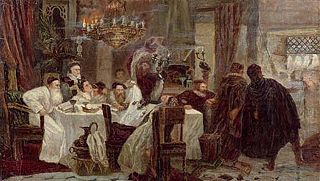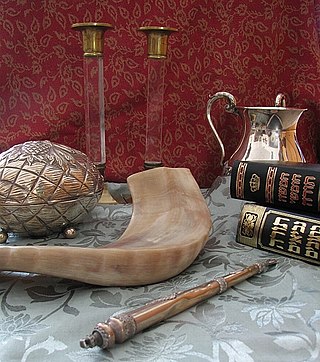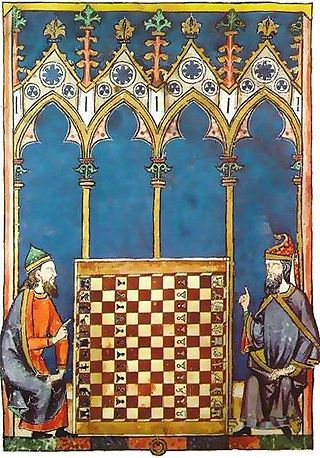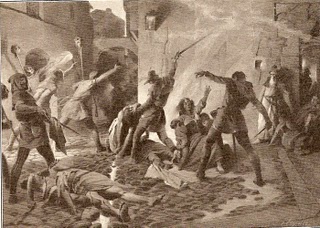Related Research Articles

SephardicJews, also known as Sephardi Jews or Sephardim, and rarely as Iberian Peninsular Jews, are a Jewish diaspora population associated with the Iberian Peninsula. The term, which is derived from the Hebrew Sepharad, can also refer to the Jews of the Middle East and North Africa, who were also heavily influenced by Sephardic law and customs. Many Iberian Jewish exiled families also later sought refuge in those Jewish communities, resulting in ethnic and cultural integration with those communities over the span of many centuries. The majority of Sephardim live in Israel.

Marranos is a term for Spanish and Portuguese Jews who converted to Christianity, either voluntarily or by Spanish or Portuguese royal coercion, during the fifteenth and sixteenth centuries, but who continued to practice Judaism in secrecy or were suspected of it. They are also called crypto-Jews, the term increasingly preferred in scholarly works over Marranos.

Crypto-Judaism is the secret adherence to Judaism while publicly professing to be of another faith; practitioners are referred to as "crypto-Jews".
New Christian was a socio-religious designation and legal distinction referring to the population of former Jewish and Muslim converts to Christianity in the Spanish and Portuguese empires, and their respective colonies in the New World. The term was used from the 15th century onwards primarily to describe the descendants of the Sephardic Jews and Moors that were baptized into the Catholic Church following the Alhambra Decree of 1492. The Alhambra Decree, also known as the Edict of Expulsion, was an anti-Jewish law made by the Catholic Monarchs upon the Reconquista of the Iberian Peninsula. It required Jews to convert to Roman Catholicism or be expelled from Spain. Most of the history of the "New Christians" refers to the Jewish converts, who were generally known as Conversos, while the Muslim converts were called Moriscos.

The Alhambra Decree was an edict issued on 31 March 1492, by the joint Catholic Monarchs of Spain ordering the expulsion of practising Jews from the Crowns of Castile and Aragon and its territories and possessions by 31 July of that year. The primary purpose was to eliminate the influence of practising Jews on Spain's large formerly-Jewish converso New Christian population, to ensure the latter and their descendants did not revert to Judaism. Over half of Spain's Jews had converted as a result of the religious persecution and pogroms which occurred in 1391. Due to continuing attacks, around 50,000 more had converted by 1415. A further number of those remaining chose to convert to avoid expulsion. As a result of the Alhambra decree and persecution in the years leading up to the expulsion of Spain's estimated 300,000 Jewish origin population, a total of over 200,000 had converted to Roman Catholicism in order to remain in Spain, and between 40,000 and 100,000 remained Jewish and suffered expulsion. An unknown number of the expelled eventually succumbed to the pressures of life in exile away from formerly-Jewish relatives and networks back in Spain, and so converted to Roman Catholicism to be allowed to return in the years following expulsion.:17
Spanish and Portuguese Jews, also called Western Sephardim, Iberian Jews, or Peninsular Jews, are a distinctive sub-group of Sephardic Jews who are largely descended from Jews who lived as New Christians in the Iberian Peninsula during the few centuries following the forced expulsion of unconverted Jews from Spain in 1492 and from Portugal in 1497. They should therefore be distinguished both from the descendants of those expelled in 1492 and from the present-day Jewish communities of Spain and Portugal.

The history of the Jews in the current-day Spanish territory stretches back to Biblical times according to Jewish tradition, but the settlement of organised Jewish communities in the Iberian Peninsula possibly traces back to the times after the destruction of the Second Temple in 70 CE. The earliest archaeological evidence of Hebrew presence in Iberia consists of a 2nd-century gravestone found in Mérida. From the late 6th century onward, following the Visigothic monarchs' conversion from Arianism to the Nicene Creed, conditions for Jews in Iberia considerably worsened.
Abulafia or Abolafia is a Sephardi Jewish surname whose etymological origin is in the Arabic language. The family name, like many other Hispanic-origin Sephardic Jewish surnames, originated in Spain among Spanish Jews (Sephardim), during the time when it was ruled as Al-Andalus by Arabic-speaking Moors.

The Portuguese Synagogue, also known as the Esnoga, or Snoge, is an Orthodox Jewish congregation and synagogue, located at Mr. Visserplein 3 in Central Amsterdam, Amsterdam, in the North Holland region of The Netherlands. The synagogue was completed in 1675. Esnoga is the word for synagogue in Judaeo-Spanish, the traditional Judaeo-Spanish language of Sephardi Jews.

The Synagogue of El Tránsito, also known as the Synagogue of Samuel ha-Levi or Halevi, is a former Jewish congregation and synagogue, located at on Calle Samuel Levi, in the historic old city of Toledo, in the province of Castilla-La Mancha, Spain.

Solomon Gaon (1912–1994) was a Sephardic Rabbi and Hakham of the Spanish and Portuguese Jews of the British Commonwealth.

The Beth Yaacov Synagogue, also known as the Beth Jacob Synagogue or the Synagogue of Madrid, is a Jewish congregation and synagogue, located at 3 Calle Balmes, in the Chamberí district of Madrid, Spain. When it opened in 1968, it was the first new synagogue building built in Spain since the Catholic Monarchs of Spain expelled the country's Jews in 1492.
Sephardic Bnei Anusim is a modern term which is used to define the contemporary Christian descendants of an estimated quarter of a million 15th-century Sephardic Jews who were coerced or forced to convert to Catholicism during the 14th and 15th centuries in Spain and Portugal. The vast majority of conversos remained in Spain and Portugal, and their descendants, who number in the millions, live in both of these countries. The small minority of conversos who emigrated normally chose to emigrate to destinations where Sephardic communities already existed, particularly to the Ottoman Empire and North Africa, but some of them emigrated to more tolerant cities in Europe, where many of them immediately reverted to Judaism. In theory, very few of them would have traveled to Latin America with colonial expeditions, because only those Spaniards who could certify that they had no recent Muslim or Jewish ancestry were supposed to be allowed to travel to the New World. Recent genetic studies suggest that the arrival of the Sephardic ancestors of Latin American populations coincided with the initial colonization of Latin America, which suggests that significant numbers of recent converts were able to travel to the new world and contribute to the gene pool of modern Latin American populations despite an official prohibition on them doing so. In addition, later arriving Spanish immigrants would have themselves contributed additional converso ancestry in some parts of Latin America.
Eastern Sephardim are a distinctive sub-group of Sephardic Jews mostly descended from Jewish families which were exiled from Iberia in the 15th century, following the Alhambra Decree of 1492 in Spain and a similar decree in Portugal five years later. This branch of descendants of Iberian Jews settled across the Eastern Mediterranean.

The Sephardic Museum is a museum in Toledo, Spain, devoted to the Jewish cultural heritage in Spain, as well as of the Sephardim, the descendants of the Jews who lived on the Iberian peninsula until 1492. It occupies the former convent of the Knights of Calatrava, annexed to the Synagogue of El Tránsito. It is one of the National Museums of Spain and it is attached to the Ministry of Culture.
The Expulsion of Jews from Spain was the expulsion of practicing Jews following the Alhambra Decree in 1492, which was enacted to eliminate their influence on Spain's large converso population and to ensure its members did not revert to Judaism. Over half of Spain's Jews had converted to Catholicism as a result of the Massacre of 1391. Due to continuing attacks, around 50,000 more had converted by 1415. Many of those who remained decided to convert to avoid expulsion. As a result of the Alhambra decree and the prior persecution, over 200,000 Jews converted to Catholicism, and between 40,000 and 100,000 were expelled. An unknown number returned to Spain in the following years. The expulsion led to mass migration of Jews from Spain to France, Italy, Greece, Turkey and the Mediterranean Basin. One result of the migration was new Jewish surnames appearing in Italy and Greece. The surnames Faraggi, Farag and Farachi, for example, originated from the Spanish city of Fraga.

The Massacre of 1391, also known as the pogroms of 1391, refers to a murderous wave of mass violence committed against the Jews of Spain by the Catholic populace in the kingdoms of Castile and Aragon, both in present-day Spain, in the year 1391, during the regency period between the reigns of John I of Castile and his successor, Henry III of Castile. It was one of the most lethal outbreaks of violence against Jews in medieval European history. Anti-Jewish violence similar to Russian pogroms then continued throughout the "Reconquista", culminating in the 1492 expulsion of the Jews from Spain. The first wave in 1391, however, marked the extreme of such violence.

The Sephardic Museum in Granada, officially the Jewish Quarter Museum, is a small museum in the city of Granada, Spain, dedicated to the recreation of the culture, history, people and traditions of the Sephardic Jews of Jewish Granada. The museum, a private initiative, occupies a typical house in the Realejo – the Jewish quarter of Granada before the expulsion of the Jews in 1492.
The Federation of Jewish Communities of Spain is the umbrella organization representing the interests of most Jews in Spain. Domestically, the FCJE is the official voice of the Spanish Jewish community to the Spanish government. Internationally, the FCJE is the Spanish representative to the European Jewish Congress and World Jewish Congress. In 2021, the FCJE estimated there were between 40,000 and 45,000 Jews in Spain, 98.5% of which are estimated to be part of communities represented by the FCJE.
Rabbi Yehuda Benasouli was a Moroccan-born Orthodox Jewish rabbi. Benasouli served as the Chief Rabbi of Madrid from 1978 until 1997.
References
- ↑ "Samuel Toledano, 66, Advocate for Jews of Spain". The New York Times. 1996-07-25. Retrieved 2020-02-21.
- ↑ Toledano, Samuel (Autumn 1990). "Toledo: Capital of Sepharad". Encounters: 37–41. Archived from the original on 2008-05-09. Retrieved 2020-02-25.
- ↑ Rein, Raanan (2006). "Diplomacy, Propaganda, and Humanitarian Gestures: Francoist Spain and Egyptian Jews, 1956-1968" (PDF). IBEROAMERICANA. América Latina - España - Portugal. 6 (23): 21–33. doi:10.18441/ibam.6.2006.23 . Retrieved 2020-02-24.
- ↑ Sachar, Howard Morley (1995). Farewell España: the world of the Sephardim remembered. New York: Vintage Books. pp. 374–375. ISBN 0-679-40960-2.
- ↑ Green, David B. (2015-12-16). "This Day in Jewish History 1968: Spain Revokes the Expulsion of the Jews". Haaretz. Tel Aviv. Retrieved 2020-02-28.
- ↑ Tigay, Alan M. (1994-02-01). The Jewish Traveler: Hadassah magazine's guide to the world's Jewish communities and sights. New Jersey: Jason Aronson. p. 283. ISBN 978-1-56821-078-0.
- ↑ "Judíos y protestantes tendrán acuerdos con el Estado similares a los católicos" [Jews and Protestants will have agreements with the State similar to Catholics]. ABC (in Spanish). Madrid. 1987-05-19. Retrieved 2020-02-21.
- ↑ "Spain Extends Guarantees to Jews and Protestants". The New York Times. 1990-02-25. Retrieved 2020-02-21.
- ↑ Illán, M. G. (1992-05-04). "Toledo entrega las llaves de la ciudad a los descendientes sefarditas de la familia Toledano" [Toledo gives the keys to the city to Sephardic descendants of the Toledano family]. ABC (in Spanish). Madrid. Retrieved 2020-02-21.